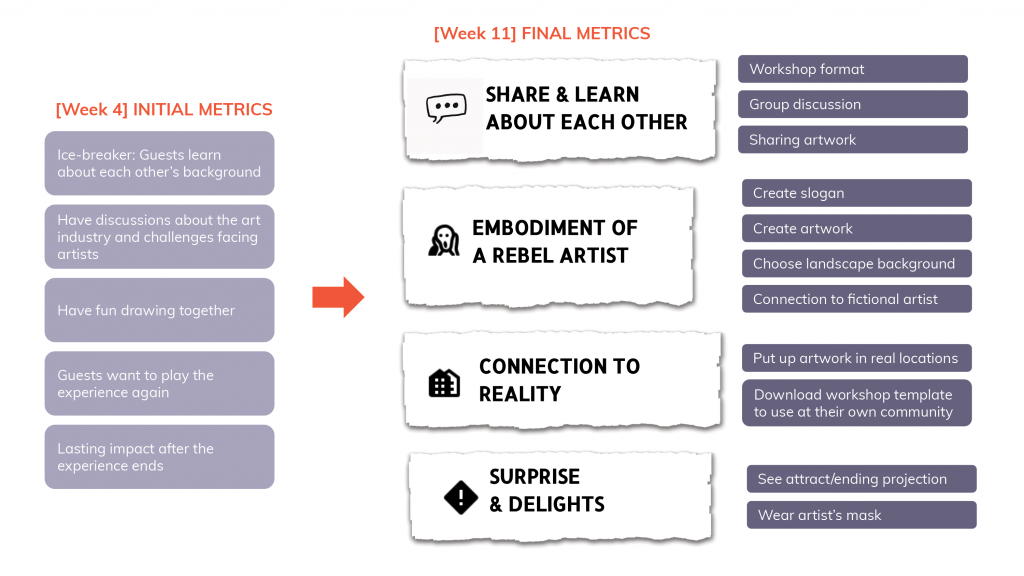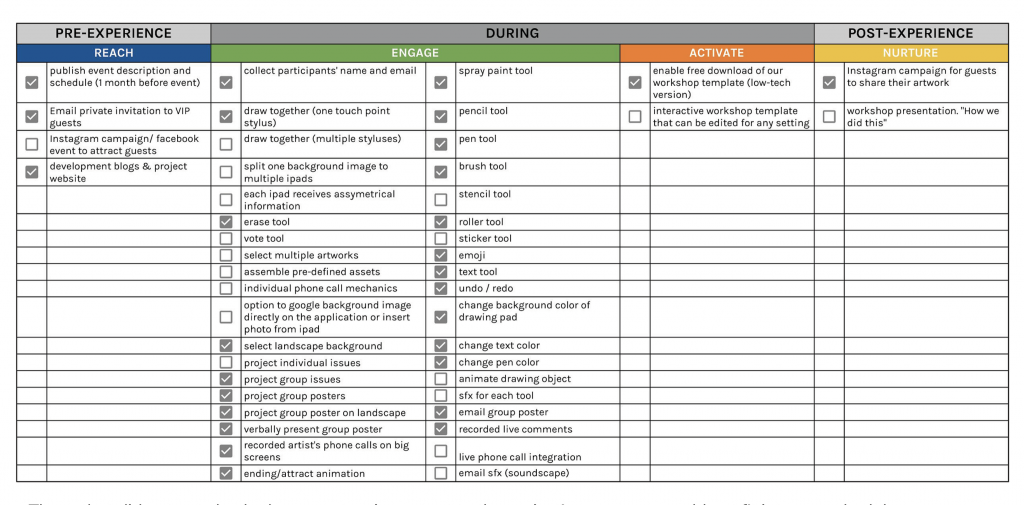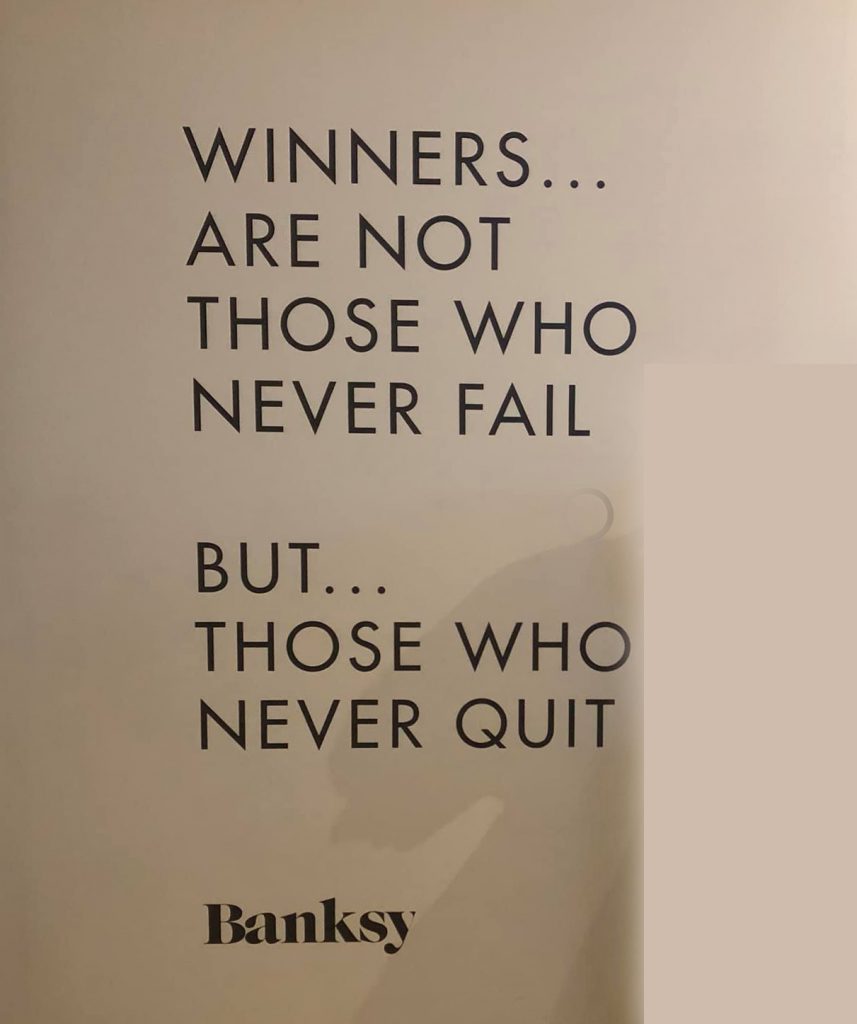THE CHALLENGE
Six graduate students at Carnegie Mellon’s the Entertainment Technology Center received a challenge to design a 1-hour experience about “Art and Civic Engagement” for the Games For Change (G4C) Festival in June 2019, at the Starr Foundation Hall in Parsons, New York City.
Please note: This is Tera’s post-mortem on our team’s overall design and processes. For more post-mortems on designing transformational games, please visit our teammates’ blogs: Kevin’s and Zoe’s.
THE OUTCOME
We delivered a multiplayer networked iPad experience on art and provocation called “Piggy Banksy Live” at the G4C Festival. The experience had more than 80 game industry professionals and educators who engaged in thought-provoking discussions on many social issues, such as women’s rights, homelessness, imposter syndrome, gaming versus saving the planet, and racism. The purpose of our experience is to foster the learning of diverse social issues through playful co-creation. We wanted to give our audience a reminder that while it is important to think, plan, and design properly for the social issues they deeply care about, the key to any impactful change relies on real-world action.
—
THE OVERALL PROCESS
We approached this project facing many upfront constraints, including a broad and subjective topic, undefined technology, a short 4-month development schedule, lack of access to the audience and event space.
Before diving into design, we used “The Transformational Framework” by Sabrina Culyba as a pre-production tool to understand the practicality of our project and the 8-step process of designing a transformational game/experience. This framework is essentially a creative problem-solving approach to game design, aimed at delivering experiences that have a lasting impact on a target audience after the gameplay. By figuring out who your audience is, the barriers that prevent them from having the transformation you aim to create, you will be able to tackle those barriers and enable your audience to be transformed.
We first looked into Games For Change as an organization and learned about their mission to empower game designers and social innovators to create impactful games through their workshops, consulting projects, and an annual festival. Following the framework, we also interviewed social practice artists whom we identified as our subject matter experts. We learned about the gatekeepers of the art industry, including lack of access to funding, infrastructure, collaboration, and our society’s conflicting valuation of the arts.
We found the two barriers: access to collaboration and valuation of the arts particularly interesting to our audience at G4C because:
(1) Conferences such as the Games For Change Festival do a great job in creating networking opportunities for attendees. However, personal effort is still heavily required in order to connect in a meaningful way, especially for those who are new to the circle.
(2) People who do not appreciate the arts often are those who think they do not have the natural talent to create art and/or understand art. Therefore, the role of art to society is not only ambiguous but also alienating to them.
As artists/designers, we believed that participatory art and co-op games are democratic and light-hearted in nature, which can attract everyone to engage regardless of who they are. This reason makes them the ideal medium to tackle the above two barriers. We then created our high-level purpose, which is to turn the Games For Change attendees into active citizens through a participatory workshop that enables everyone to act like activist artists. We built our design pillars around the perspective and processes of artists whom we interviewed for our project.
For the first barrier, by creating guided opportunities for individual reflection, group discussions, and presentations, we enabled our audience to learn about each other (and the social issues) on a deeper and more engaging level. We hope that this will lead to more future collaboration on impactful projects.
For the second barrier, by focusing on the quality of discussion and collaboration rather than drawing, we transformed our audience’s self-doubt to the “just do it” mentality. To us, that is the value and beauty of civic art: content and context matter more than technique, vulnerability is more beautiful than perfection, and letting go of individualism enables you to truly see others.
Lastly, we believe that impactful change happens through fruitful conversations that are initiated often by diverse groups of people. Therefore, we released a low-tech template of our experience that can be downloaded from our project website and customized for an communities. And by wearing the masks, we hope you can express yourself openly without being afraid of being judged while feeling united as a collective group for social change.

The Transformational Framework enabled us to focus on design features that satisfied our mission and pillars, which solved many internal conflicts when our team had many spontaneous ideas.

OTHER RESOURCES WE USED
In parallel with The Transformational Framework, we also used:
“The Golden Circle” by Simon Sinek to ground our design ideas with meaning. Our team constantly asked each other: How does this feature achieve the product’s goals? What makes our product unique compared to existing ones in the market? What are we trying to improve?
“The ICAP Framework” by Micki Chi to help us design our workshop experience to foster active learning in our audience.
“How To Be a Guerrilla Artist” by Keri Smith to give us a reference on guerrilla artists’ tools and processes.
“The Art of Game Design” by Jesse Schell to help us create a believable and engaging fictional experience using indirect control. The guerrilla artist’s toolkit, the dynamic display of social issues, the Piggy masks, the ipad illustrations, the activity prompts, the slogan, the poster, the artist’s phone calls – all were designed to enable participants to feel and act like an activist artist.
ADVISE FOR FUTURE TEAMS USING TRANSFORMATIONAL FRAMEWORK?
I personally recommend the entire team at ETC to use the first 2-3 weeks to familiarize themselves with the framework. This helps establish a common understanding between all team members on what transformational games are (at least to the CMUETC’s standard) and key things to consider when designing games to solve a problem, and not just for entertainment values.
The framework should not be used as a single design resource, but rather a pre-production (or product management) tool. We trusted our instinct as designers to find other inspirations the project needed, while using the framework to evaluate whether our design achieved the transformation goals we had for our audience.
OUR TOUGHEST CHALLENGES AS A TEAM
To us, transformational games are hard to define because we believe it is never easy to change people, how to measure the transformation we create, and how do we know the initial state of our diverse audience when we don’t have much access to them?
Additionally, since our topic is about designing an experience on art, we also ran into a tension between art and design. We found that the process of creating art can be very different from the process of creating design. Art evolves so much around an individual’s interest and context, whereas design is about making iterative decisions for an end-product that is directly useful for someone else. For this project, we struggled to identify whether our team should follow the process of art or design. We wanted to truthfully represent the artists and their work processes, but what does it mean to embody an artist’s perspective when we have six team members with six different philosophies?
Eventually, we decided to steer away from putting our personal philosophy about art on the audience, and instead enabling the audience to bring their own stories to our experience.
WHEN TO RELY ON A SUBJECT MATTER EXPERT?
We highly recommend teams to have an expert assigned as soon as they know their topic space. For our project, we weren’t given an expert so we spent 11 weeks (3/4 of the project’s timeline) to identify them ourselves. We ended up interviewing many types of experts from art funders, curators, educators, to artists, who gave us a broader understanding of our topic but inadvertently distracted us from finding our focus. Luckily, with persistence from our team and guidance from our advisors and Sabrina, we were able to find social practice artists and workshop instructors as our experts.
THINGS TO CONSIDER WHEN INTERVIEWING EXPERTS
Before interviewing experts, our team skimmed through their background online and prepared a list of 5-6 questions for them. All of our interviews happened over the phone. We let one person take charge of asking questions so it would be easy for the expert to listen. We took notes on paper and Docs.
During the interview, we asked about the experts’ background, their motivation, and work process. We did not ask the experts for design solutions, but instead focus on the challenges they face and what they wish to have in order to do their work more effectively.
For the first talk, we scheduled a 1-hour appointment and asked whether we can have weekly 30-minute follow-up calls. However, we realized that talking to multiple experts once rather than one expert multiple times was more useful for our project.
PROGRAMMERS’ ROLE ON THE PROJECT
Since this was a research and design-heavy project, our programmers felt like they were more in a supporting role. However, because of the tie to our location at Parsons (which has a relatively slow network bandwidth), tech implementation had a huge impact on how our design was shaped. Our programmers and designers were constantly in a push-n-pull relationship where both sides would come up with different ways to implement each other’s ideas. These ideas sometimes worked well together and sometimes they crashed. It is important to create opportunities for individual ownership, to trust in your teammates’ expertise, and to understand that their suggestions come from the tools and strengths they have.
TIPS FOR PRODUCERS
Keeping track of milestones, schedule, and applying a suitable development process for your team is a producer’s job. I found that writing weekly blogs in addition to having team’s casual retrospective discussions really helped me reflect on the team’s progress and what I should iterate or plan for the following weeks. From Week 8 to 11, I neglected the blogs due to my preparation for the GDC conference and it had a clear negative impact on my performance and the team. When Zoe emailed me during GDC asking what she should be delivering for the upcoming week, I knew I had forgotten to see the bigger picture of what was needed to be done. Just like designers should sketch or create tangible prototypes, producers should invest time every week to document the team’s progress. Structure the blogs in a way that they can become useful to you and your team. Make them easy to digest with photos and diagrams. Don’t wing them just for the grades of completion.
WHAT WE WOULD HAVE DONE DIFFERENTLY
I personally wish we had put more time and effort to go through an exercise of analyzing our “Concept domains & Sub-domains” (noted in the framework). After landing our high-level transformational goals and a basic skeleton of our experience by Halves, our team went too deep in certain interpretations of the gatekeepers (i.e: conflicts in social values between the audience and the artist’s artwork, the challenges facing interdisciplinary collaboration, the self vs. the community) that we did not go through the practice of analyzing all other possible areas. Consequently, although we successfully identified the “why” it is important to transform our audience into active citizens, and “what” activities enable that goal, we struggled for weeks to identify “how” they could be become active citizens through the power of art (which is to become an activist artist themselves).
What you read in this post-mortem sounds like a linear and no-brainer design process, but we actually had so many unique directions that we could take. Building a visual mind-map with sticky notes and images would help the team see things with more clarity and less attached to a single direction that may not work.
FINAL TIPS
1/ Don’t fall in love with your first design idea. The probability of landing the perfect design at first try is very low. This project is all about asking questions, gathering information, and making decisions with the information we have. I suggest to find fast and easy ways to prototype many different directions so you can learn the pros and cons for each. Do not rush to merge everything together for the final design but be analytical about each direction as a team. Eventually you will find a pattern of ideas that excite your team, your players, and the final design will evolve from these lessons learned. When every feature can be explained with a mission statement, that’s when you know you got it. If the feature can’t be explained, then it either needs more work or your mission is not actionable enough.
2/ Plan a schedule and playtest metrics so you don’t waste time and effort on directions that don’t matter. Think of this as modern dating (lol) – your quest of looking for “the one” to marry. Initially you may have some vague ideas on who they are. Technology today makes it relatively easy to meet people and try out different relationships before you commit. Your ideas of a perfect partner will evolve as you learn what’s best for you. However, know what you want to learn and how that can lead you closer to your goal…so you don’t waste time and effort swiping right to everyone on Tinder.
3/ Turn ideas into sketches. Every week, our team communicated our goals verbally AND visually through sketches, paper prototypes, and wireframes to ensure that we were aligned. We documented our learnings on the whiteboard and at places in the project room that were convenient for us and our stakeholders to look at. Sticky notes, large post-it sheets, pens and markers were our go-to tools. For more references on prototyping and playtesting, you can find online resources from Google, Invision, or talk to Dave and Jessica Hammer.
4/ Establish a common understanding between team members on design and software development processes. Even better, establish expectation on what a “done” task means. Since everyone from the ETC comes from a different background, make sure your team understands Scrum, how to do effective documentation, what it means to do research, make paper prototypes, or how to create an engaging and visually effective presentation. Doing this will help resolve any confusion or unnecessary conflicts that may arise.
5/ Assign people on the right role and enable ownership. This project was so successful because of the different perspectives, skills, and personalities our team has. We did our best to celebrate each other’s strengths and enable everyone to have autonomy of their own work. We also implemented and iterated weekly on processes that would work for us. Of course, interdisciplinary collaboration without conflicts is a myth! When we got frustrated with each other, we usually took a walk, ate some food, played silly games, and be opened about our feelings to each other.
6/ Know that it’s okay to not have all the answers at times! Our team often did not know whether we did things right. We only knew our goal as a team was to not settle for mediocrity and we did not give up on trying out new approaches that felt right for the team. No matter how prepared we were, certain things still went wrong. We learned to be flexible to changes, and drinking a lot of Boba tea to calm us down.
7/ Games For Change teams should memorize these pillars: Design with practicality; Present with preparation (a lot of it); React to changes with flexibility. Enough said lol
Transformational games/experiences are definitely not easy to create. But don’t give up on the challenge, and don’t kill your teammates.
Good luck! 😉
